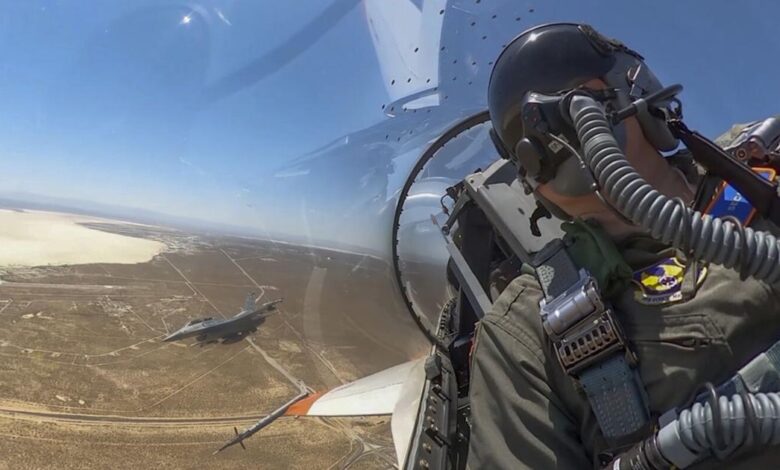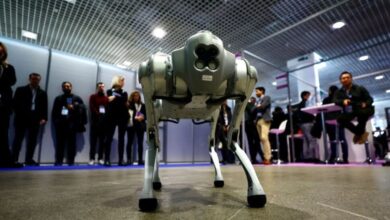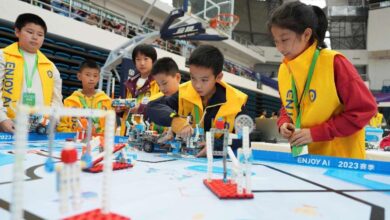AI fighter jet takes US Air Force leader for historic ride

EDWARDS AIR FORCE BASE, Calif. — With the midday sun blazing, an experimental orange and white F-16 fighter jet launched with a familiar roar that is a hallmark of U.S. airpower.
But the aerial combat that followed was unlike any other: This F-16 was controlled by artificial intelligence, not a human pilot. Riding in the front seat was Air Force Secretary Frank Kendall.
AI marks one of the biggest advances in military aviation since the introduction of stealth in the early 1990s, and the Air Force aggressively leaned in. Even though the technology is not fully developed, the service is planning for an AI-enabled fleet of more than 1,000 unmanned warplanes, the first of them operating by 2028.
Maj. Ryan Forystek, left, a pilot for SecAF flight, and Air Force Secretary Frank Kendall climb into the cockpit of the artificial intelligence-controlled X-62A VISTA aircraft Thursday at Edwards Air Force Base, Calif.
It was fitting that the dogfight took place at Edwards Air Force Base, a vast desert facility where Chuck Yeager broke the speed of sound and the military incubated its most secret aerospace advances. Inside classified simulators and buildings with layers of shielding against surveillance, a new test-pilot generation is training AI agents to fly in war.
People are also reading…
Kendall traveled here to see AI fly in real time and make a public statement of confidence in its future role in air combat.
“It’s a security risk not to have it. At this point, we have to have it,” Kendall said in an interview with The Associated Press after he landed.
Air Force Secretary Frank Kendall takes an experimental flight inside the cockpit of a X-62A VISTA aircraft autonomous warplane Thursday above Edwards Air Base, Calif.
The AP, along with NBC, was granted permission to witness the secret flight on the condition that it would not be reported until it was complete because of operational security concerns.
The AI-controlled F-16, called Vista, flew Kendall in maneuvers at more than 550 miles an hour that put pressure on his body at five times the force of gravity. It went nearly nose to nose with a second human-piloted F-16 as both aircraft raced within 1,000 feet of each other, twisting and looping to try to force their opponent into vulnerable positions.
At the end of the hourlong flight, Kendall climbed out of the cockpit grinning. He said he’d seen enough during his flight that he’d trust this still-learning AI with the ability to decide whether or not to launch weapons in war.
Air Force Secretary Frank Kendall smiles Thursday after a test flight of the X-62A VISTA aircraft against a human-crewed F-16 aircraft in the skies above Edwards Air Force Base, Calif.
However, arms control experts and humanitarian groups are deeply concerned that AI one day might be able to autonomously drop bombs that kill people without further human consultation, and they seek greater restrictions on its use.
“There are widespread and serious concerns about ceding life-and-death decisions to sensors and software,” the International Committee of the Red Cross warned. Autonomous weapons “are an immediate cause of concern and demand an urgent, international political response.”
Kendall said there will always be human oversight in the system when weapons are used.
Air Force Secretary Frank Kendall sits in the front cockpit of an X-62A VISTA aircraft Thursday at Edwards Air Force Base, Calif.
The military’s shift to AI-enabled planes is driven by security, cost and strategic capability. If the U.S. and China should end up in conflict, for example, today’s Air Force fleet of expensive, manned fighters will be vulnerable because of gains on both sides in electronic warfare, space and air defense systems.
China’s air force is on pace to outnumber the U.S. and it also is amassing a fleet of flying unmanned weapons.
Future war scenarios envision swarms of American unmanned aircraft providing an advance attack on enemy defenses to give the U.S. the ability to penetrate an airspace without high risk to pilot lives.
But the shift is also driven by money. The Air Force is still hampered by production delays and cost overruns in the F-35 Joint Strike Fighter, which will cost an estimated $1.7 trillion.
Smaller and cheaper AI-controlled unmanned jets are the way ahead, Kendall said.
Air Force Secretary Frank Kendall addresses the future role of artificial intelligence in air combat Thursday at USAF Test Pilot School at Edwards Air Force Base, Calif.
Vista’s military operators say no other country in the world has an AI jet like it, where the software first learns on millions of data points in a simulator, then tests its conclusions during actual flights.
That real-world performance data is then put back into the simulator, where the AI then processes it to learn more.
China has AI, but there’s no indication it found a way to run tests outside a simulator.
And, like a junior officer first learning tactics, some lessons can only be learned in the air, Vista’s test pilots said.
Until you actually fly, “it’s all guesswork,” chief test pilot Bill Gray said. “And the longer it takes you to figure that out, the longer it takes before you have useful systems.”
An AI-enabled Air Force F-16 fighter jet, left, flies next to an adversary F-16, as both aircraft race within 1,000 feet of each other Thursday above Edwards Air Force Base, Calif.
Vista flew its first AI-controlled dogfight in September 2023, and there have only been about two dozen similar flights since.
Still, the programs are learning so quickly from each engagement that some AI versions getting tested on Vista already are beating human pilots in air-to-air combat.
The pilots at this base are aware that in some respects, they may be training their replacements or shaping a future construct where fewer of them are needed.
They also say they would not want to be up in the sky against an adversary that has AI-controlled aircraft if the U.S. does not also have its own fleet.
“We have to keep running,” Kendall said, “and we have to run fast.”
How AI can—and can’t—boost efficiency for programmers
How AI can—and can’t—boost efficiency for programmers
Artificial intelligence took the world by storm when OpenAI launched ChatGPT in November 2022.
Although its creators didn’t tailor the product for any specific purpose or profession, the simple chatbot quickly proved a nimble and capable tool for countless tasks. People could use it to conduct research, write school essays, and even generate love letters in the voice of celebrities. The tool enamored people around the globe.
But, for many professionals—particularly computer programmers—OpenAI presents both a career advantage and a professional threat.
AI naturally lends itself to some computer programming tasks, like code documentation. Although many leading AI models were not explicitly trained in software development, their users quickly discovered these tools could be as adept at programming languages as human ones.
Trends in programmers’ use of AI are still emerging. Verbit analyzed data from various surveys to see how AI is changing software developers’ work.
Despite varied survey results, one thing is clear: Programmers are adopting AI tools at a dizzying pace. A March 2023 GitHub survey of 500 U.S. developers found that the vast majority, 92%, use AI coding tools both in and outside of work.
Taking a broader view, just over 3 in 4 programmers used ChatGPT, according to a JetBrains survey of some 26,000 developers from around the world. Nearly half of those surveyed used GitHub Copilot, a programming assistant similar to autocomplete that launched in 2021. Survey data from StackOverflow in 2023, which polled programmers from 10 countries, including the U.S. and Canada, found that 44% of professional developers used artificial intelligence for work.

Who benefits the most?
McKinsey conducted an experiment with over 40 of its programmers, asking them to complete tasks of varying difficulty levels in a lab. They found that developers who used AI for a simple task, code documentation, finished their work in around half the time it took their peers who did not use AI. Artificial intelligence was far less effective at helping complete more complicated tasks, only saving developers about 10% of their time to finish their work compared with their colleagues who did not.
Another study, published by researchers at Microsoft, GitHub, and MIT, analyzed the impact of a particular AI tool (GitHub Copilot) on the productivity of freelance programmers. On average, programmers who had access to Copilot completed their work about 55% faster than those who did not.
However, not all of the workers benefited from AI assistance equally. The researchers found that less-experienced workers, older programmers (between 25 and 44), and those with heavier workloads were much more likely to benefit from using AI than their peers.
How far will AI go?
Despite AI’s added value in expediting repetitive or mundane tasks, many programmers remain skeptical about its broader implications. JetBrains data indicates that 59% of developers have security concerns about generative AI, while 42% agree that its use presents ethical challenges.
Artificial intelligence tools can also be unreliable, suffering from the same confabulation problem as chatbots. AI’s tendency to generate complications of facts that can be misleading or downright false might be why AI has yet to earn the trust of developers. Less than 3% of developers say they “highly trust” AI, while about 39% say they only “somewhat trust” AI, according to the StackOverflow survey.
Scores of new startups are trying to push the technology forward. Devin by Cognition Labs is one product piquing the interest of investors and engineers. Advertising itself as “the first AI software engineer,” the company boasts that its software can beat other leading AI tools at meeting computer programming benchmarks and completing software engineering tasks with minimal supervision. However, the product hasn’t launched yet, and because it relies on the same technology that powers ChatGPT, it could share many of the same weaknesses regarding complex problem-solving.
Despite suggestions that AI will trounce human capacity, software developers are generally optimistic about AI’s impact on their work. According to the JetBrains survey, 60% of programmers believe AI coding tools will dramatically alter the job market for software development, while just over half think AI will boost demand for human programmers. Only a fraction, 13%, believe AI will completely replace human developers.
The technology behind many artificial intelligence tools is advancing at lightning speed. Though speculation on the future of AI abounds, there are still more questions than answers about what’s next. For now, though, computers are augmenting human intelligence—not replacing it.
Story editing by Alizah Salario. Copy editing by Kristen Wegrzyn.
This story originally appeared on Verbit and was produced and distributed in partnership with Stacker Studio.



